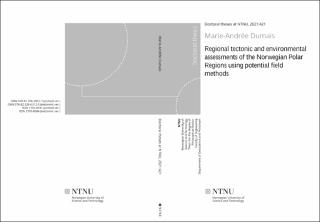| dc.contributor.advisor | Brönner, Marco | |
| dc.contributor.advisor | Smelror, Morten | |
| dc.contributor.advisor | Johansen, Ståle Emil | |
| dc.contributor.author | Dumais, Marie-Andrée | |
| dc.date.accessioned | 2022-02-04T12:13:23Z | |
| dc.date.available | 2022-02-04T12:13:23Z | |
| dc.date.issued | 2021 | |
| dc.identifier.isbn | 978-82-326-6312-5 | |
| dc.identifier.issn | 2703-8084 | |
| dc.identifier.uri | https://hdl.handle.net/11250/2977180 | |
| dc.description.abstract | Interest for the polar regions has increased during the last few decades. New technologies now allow to conduct research in this hostile environment. Tectonic history and timing of the opening of the Arctic is the key to understand the geological framework of this area. Climate and environmental research necessitate a deeper understanding of the polar regions to model the global ecosystem and create robust global weather and climate change prediction scenarios. In this work, we addressed the Norwegian Polar Regions by studying the spreading of the Knipovich Ridge, the regional tectonic of the Fram Strait and the Svalbard Margin, the thermal activity and fluid circulation of Loki’s Castle and its surroundings, and the bed topography and geology under Austfonna icecap.
All these facets of the Norwegian Polar Regions have been investigated with a common methodology: potential fields theory. We developed tools to recognize the underground settings of various types of environment at different scale within the Norwegian Arctic. The data interpretation and analysis are mainly based on 2-D forward modelling, 3-D inversion modelling, Werner deconvolution and plate tectonic reconstruction.
Newly acquired aeromagnetic data revealed several fracture zones and lineaments in the Fram Strait. The high-resolution data identified the magnetic isochrons of the Knipovich Ridge. The ridge spreading initiated at C6 (20 Ma) and a ridge jump occurred at C5E. The 2-D magnetic and gravity forward modelling interpreted the crustal and thermal heterogeneities of the Fram Strait and Svalbard Margin. The crustal domains were consequently delineated and confirmed with the Werner deconvolution and Curie point depth estimation. The 3-D magnetic inversion modelling identified zone with weak magnetization along the rift valley correlated with the absence of volcanic and bathymetric rise evidence. The continent-ocean boundary on the east margin is relocated up to 160 km west of the location set by previous studies.
With an autonomous underwater vehicle, magnetic data were collected and analysed to identify hydrothermal mineral deposits. Loki’s Castle, Mohn’s Treasure and an area called AVR2 were investigated to correlate the magnetic response to the hydrothermal venting activity at each location. Evidence of two new deposits was suggested through the study. Using the aeromagnetic data, a small-scale analysis, using 2-D forward model, linked to the geological structure, geometry, and fluid circulation beneath Loki’s Castle, located in the rift valley of Mohn’s Ridge. A thin crust is expected under the ridge and weak magnetization of the basalt layer is correlated to the fluid circulation.
2-D magnetic and gravity forward modelling improved the morphology and glacial bed topography derived from ground penetrating radar technique on Austfonna icecap. Enhanced with magnetic interpretation, the geology is also derived under the icecap revealing a heterogeneous bedrock with variable erodibility and the presence of intrusions potentially important for the basal thermal regime of the icecap. | en_US |
| dc.language.iso | eng | en_US |
| dc.publisher | NTNU | en_US |
| dc.relation.ispartofseries | Doctoral theses at NTNU;2021:421 | |
| dc.relation.haspart | Dumais, Marie-Andrée; Gernigon, Laurent; Olesen, Odleiv; Johansen, Ståle Emil; Brönner, Marco.
New interpretation of the spreading evolution of the Knipovich Ridge derived from aeromagnetic data. Geophysical Journal International 2021 ;Volum 224.(2) s. 1422-1428
https://doi.org/10.1093/gji/ggaa527
- This is an Open Access article distributed under the terms of the Creative Commons Attribution License (CC BY 4.0) | |
| dc.relation.haspart | Crustal and Thermal Heterogeneities Across the Fram Strait and the Svalbard Margin.
The final published version is available in
Tectonics Volume41, Issue10, 2022
https://doi.org/10.1029/2022TC007302
- This is an open access article under the terms of the Creative Commons Attribution License (CC BY 4.0) | |
| dc.relation.haspart | Lim, Anna; Brönner, Marco; Johansen, Ståle Emil; Dumais, Marie-Andrée.
Hydrothermal activity at the ultraslow‐spreading Mohns Ridge: new insights from near‐seafloor magnetics. Geochemistry Geophysics Geosystems 2019 ;Volum 20.(12) s. 5691-5709
https://doi.org/10.1029/2019GC008439
- This is an open access article under the terms of the Creative Commons Attribution License (CC BY 4.0) | |
| dc.relation.haspart | Dumais, Marie-Andrée; Brönner, Marco.
Revisiting Austfonna, Svalbard, with potential field methods - A new characterization of the bed topography and its physical properties. The Cryosphere 2020 ;Volum 14. s. 183-197
https://doi.org/10.5194/tc-14-183-2020
- This is an open access article under the terms of the Creative Commons Attribution License (CC BY 4.0) | |
| dc.title | Regional Tectonic and Environmental Assessments of the Norwegian Polar Regions using Potential Field Methods | en_US |
| dc.type | Doctoral thesis | en_US |
| dc.subject.nsi | VDP::Technology: 500::Rock and petroleum disciplines: 510::Petroleum engineering: 512 | en_US |
| dc.description.localcode | Fulltext is not available | en_US |
